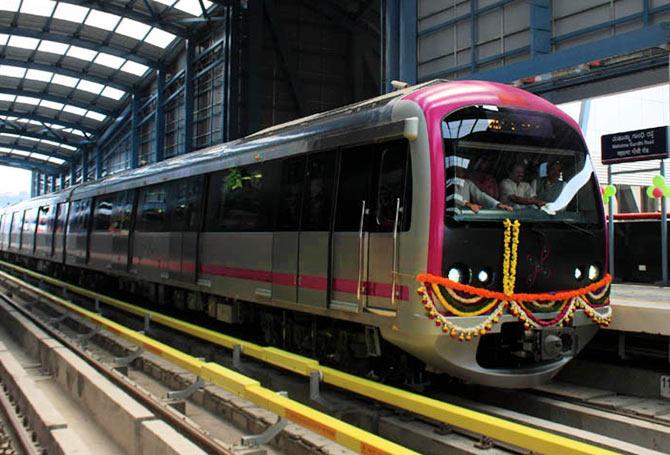Now, that the word infrastructure is back in the limelight, should you go for it? Better stick to equity diversified funds, says Larisssa Fernand of Morningstar.in.

It's hard to talk about infrastructure funds without injecting a tone of disdain.
The infrastructure theme was birthed a decade ago and investors flocked to the funds when the returns delivered were stupendous. The story almost sold itself as investors were licking their 2008 bear market wounds. The funds never did fully recover. Until now!
As the market celebrated with the new government in place, infrastructure stocks were ardently courted. And infrastructure funds seem to have been finally lifted out of their funk. Investors looking at the latest returns might well get swayed. As of today, there are 16 funds going under the infrastructure tag that have posted 1-year returns above 70 per cent.
In the past few months, UTI Infrastructure and DSP BlackRock T.I.G.E.R. completed a decade in existence. (Tata Infrastructure will do so by the end of this calendar year). The timing, by way of election results and the stock market rally, could not have been better. Billboards across the country reminded investors that the 'T.I.G.E.R. is ready to roar'. Both these funds have delivered 1-year returns above 70 per cent. Even if one looks at the 10-year return, investors in these funds have been well rewarded. UTI Infrastructure boasts of a CAGR of 16 per cent and T.I.G.E.R., 19 per cent.
But does that mean it's a good investment?
The infrastructure ride has been rocky, to say the least. Though the earlier years were great, from 2008 the funds began to falter as their performance coincided with the down cycle in most sectors of the infrastructure segment. Investors learnt the hard way. Having a restrictive investment universe can be very rewarding at times, but also very risky given the cyclical nature of stocks in the portfolio.
What constitutes such a fund?
Such funds tend to follow an unconstrained approach when picking stocks with no particular bias – growth, value, leveraged companies, non-leveraged, high quality, relatively lower quality and so on and so forth. The fund managers make their respective pick on a case-to-case basis.
Where the confusion arises is in what comprises infrastructure. There is no standard definition to rely upon. A while back, the Insurance Regulatory and Development Authority, or IRDA, stated that it would align its definition of infrastructure with that of the Cabinet Committee on Infrastructure. The Reserve Bank of India, Securities and Exchange Board of India, Planning Commission, Pension Fund Regulatory and Development Authority, and the Income-Tax department—all have different definitions as to what constitutes infrastructure.
A natural extension would be that individual fund managers would concoct their own definitions too. PineBridge Infrastructure & Economic Reform sticks to the definition adhered to by Planning Commission. Others tend to essentially look at the obvious such as construction and capital goods. They then use their discretion regarding industries or sectors that are indirectly linked to the creation of infrastructure or benefit from its growth. Some believe that oil production and exploration firms should not be included in the definition of 'infrastructure' since these are more users of infrastructure rather than contributors. A contradicting view is that they must be included since it requires investment in complex, long-lasting and huge amounts of infrastructure.
Most funds also invest in banks since some of them have sizeable exposure to infrastructure projects. HDFC Infrastructure Fund has State Bank of India, ICICI Bank, Bank of Baroda, Federal Bank and Punjab National Bank in its portfolio. But there will be other funds that are not inclined towards banking stocks in their infrastructure portfolio.
By and large, pharmaceutical companies, technology, FMCG and automobiles (consumer related) would not be found in an infrastructure fund. Do note, I stated "by and large". There have been instances of pharma being included in the portfolio of an infrastructure fund on the premise that healthcare is a part of the overall infrastructure of a country. A few years back, an education stock featured in one fund's portfolio since the fund manager reasoned that education falls under the 'social infrastructure' of a country. HDFC Infrastructure Fund also has Infosys (IT) and Wonderla Holidays (Services), while L&T Infrastructure Fund has Blue Dart Express (Transportation, according to Morningstar's sector categorisation).
The point I am making is that since there is so much ambiguity in what constitutes infrastructure, it is difficult for investors to actually narrow down on a "pure infrastructure" fund—if such a product actually exists.
What does one do?
Our advice: Stick to equity diversified funds.
If you want to take a specific exposure to a fund focused on the so-called infrastructure theme, do go ahead. The crucial factor will be deciding which fund to opt for.
Start by evaluating the fund on general parameters. Look at the fund manager's view on cash, how concentrated the portfolio is, whether the portfolio tilts towards large caps or smaller fare, the turnover ratio, the consistency of performance vis-à-vis its peers, volatility and expense ratio.
When you finally zoom in on a few that meet your selection criteria, read each of the fund's prospectus to look at the investment mandate. That will give you a clear indication as to whether it has a more narrow focus than the other infrastructure funds or is just a guise for another diversified equity fund.
Finally, ensure that such a fund does not form a core holding in your portfolio.
Photograph: Rediff Archives











